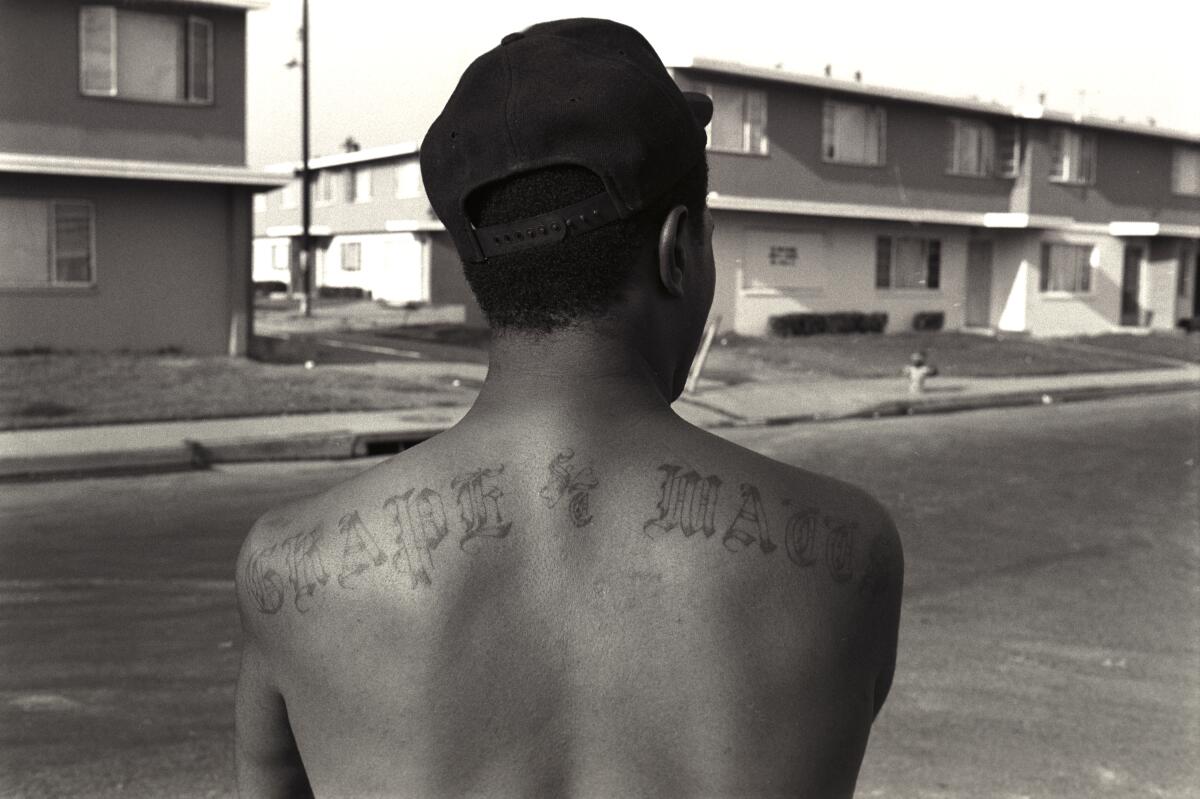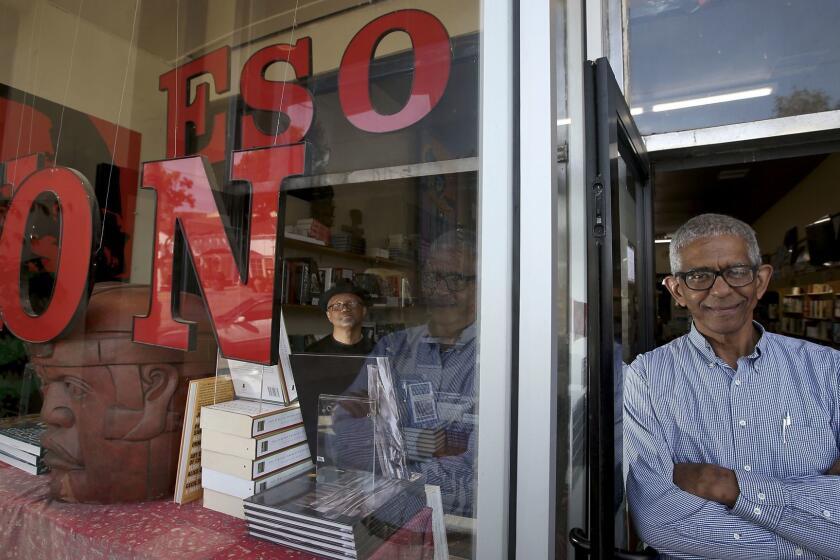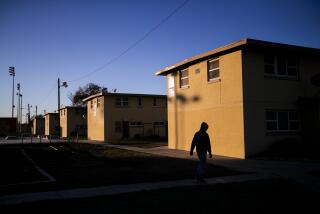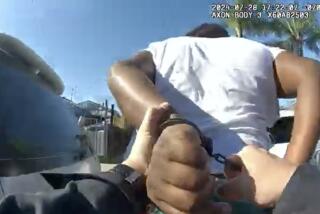Op-Ed: How four gangs in Watts brokered a historic peace treaty

A hidden history lies beneath the world where racism flattens lives by creating poverty and violence. Within this history, overlooked stories show that marginalized communities can achieve meaningful change as they seek to overcome years of neglect and discrimination. That’s what happened on the eve of the L.A. uprising 30 years ago next week.
In April 1992 — days before unrest would erupt citywide after the police officers who beat Rodney King were acquitted — a small group of gang leaders and community organizers drafted an agreement to curtail endemic violence in South Los Angeles. Several gangs accepted the truce and established a cease-fire agreement.
Local activists and even public officials eventually recognized that the 1992 Watts treaty succeeded for years in reducing gang violence throughout the community, including the major housing projects in Watts. As we approach the 30th anniversary of the L.A. uprising, and consider the upswing in homicides that L.A. has experienced the last two years, this history carries lessons for today.
Neighborhoods: Rival gang members for the most part are not killing each other. But the spirit of entrepreneurialism after the riots has dissolved.
The Watts treaty originated from the desire of some gang leaders to end the death and violence that plagued their community. They were motivated to protect their families and friends from indiscriminate shootings and targeted attacks.
They recognized that law enforcement could not, or would not, end the violence. These leaders — Aqeela and Daude Sherrills, Twilight Bey, Anthony Perry, Dewayne Holmes, Tony Bogard and others — saw the devastating struggle between gangs as analogous to military conflict, complete with “no-man’s land” where rivals would be shot on sight, the use of assault weapons, targeted killings and civilian casualties. They realized such violence required a diplomatic solution.
Seeking inspiration from international conflict resolution, gang leaders visited local libraries to search for documents that could provide a template for their own agreement. Perry scoured library shelves at USC and eventually found the 1949 Armistice Agreement adopted by Egypt and Israel to end the Arab-Israeli War. That agreement brokered an exchange of prisoners and established an armistice line, which separated the two sides and prohibited the use of military force by either party.
The Egypt-Israel Armistice Agreement took on even greater meaning to gang leaders when they discovered that its principal architect was Ralph Bunche, an American diplomat who worked for the United Nations. More significantly, Bunche was African American with strong roots in Los Angeles, having graduated from Jefferson High School and UCLA. Bunche eventually received the Nobel Peace Prize for his mediation efforts during the 1948 Arab-Israeli War, including his work on the armistice agreement.
When I interviewed Aqeela Sherrills about the formation of the Watts treaty, he told me Bunche’s personal connection to the Black community in L.A. confirmed to the drafters that they were pursuing the right course of action.
Perry copied the Egypt-Israel Armistice Agreement by hand. Working with other gang leaders to draft the Watts treaty, Daude Sherrills mirrored key provisions of that agreement. The treaty included a cease-fire arrangement and other confidence-building measures, such as prohibiting drive-by shootings and indiscriminate attacks. It also addressed community issues, including the need to support Black businesses and educational programs.
The 4300 block of Degnan Boulevard in Leimert Park has a look of faded glory, with its shuttered storefronts and stalled promise.
A separate United Black Community Code served as a code of conduct for gang members and prohibited the use of gang signs and the wearing of provocative clothing. The treaty applied to four of the main gangs in Watts: the Grape Street Crips, PJ Watts Crips, Bounty Hunter Bloods and Hacienda Village Bloods.
On April 26, 1992, the Watts treaty entered into force. It was tested immediately when the L.A. uprising began on April 29. Despite violence throughout the city, the truce held. None of the deaths during the uprising were attributed to gang rivalries. Police records also showed a marked decrease in gang violence in the following months.
The different-colored bandannas that once signaled gang affiliation — red for Bloods and blue for Crips — became symbols of unity when gang members tied them together in a show of solidarity. Those who had previously attacked rivals on sight were now “bound by a peace treaty,” as the L.A. rapper Kam put it in his 1993 hit single.
Apart from its practical significance, the Watts treaty had profound cultural effects. It was referenced in rap music. It received radio and TV coverage. It inspired poetry. It influenced theater and was mentioned in documentaries and movies. The treaty even led to a beer called Watts Truce.
Political leaders had mixed reactions to the treaty. Some local politicians, like Rep. Maxine Waters and then-state Sen. Tom Hayden, became strong supporters. Police at the time were skeptical, and some public officials were reluctant to provide gang leaders with any recognition or support.
The treaty remained in force for several years, with no official date that signaled its end. Gang leaders who drafted the agreement left the community, and connections between the treaty and the gangs began to fade. Lack of public support, including economic development and employment opportunities for the affected neighborhoods, also hampered the truce’s long-term prospects.
Despite its importance, the Watts treaty has largely been forgotten, perhaps because it provides a counter-narrative to dominant perceptions of Watts. There was poverty and violence in South L.A. But there was also community, creativity and hope as peacemakers sought to build a better life.
There are lessons in this history. Community-led intervention can reduce violence, but public support is essential for long-term success. Three decades later, the legacy of the Watts treaty still resonates.
William J. Aceves is a law professor at California Western School of Law in San Diego. This article is adapted from his forthcoming article on the Watts Treaty in the Harvard Civil Rights-Civil Liberties Law Review.
More to Read
A cure for the common opinion
Get thought-provoking perspectives with our weekly newsletter.
You may occasionally receive promotional content from the Los Angeles Times.











